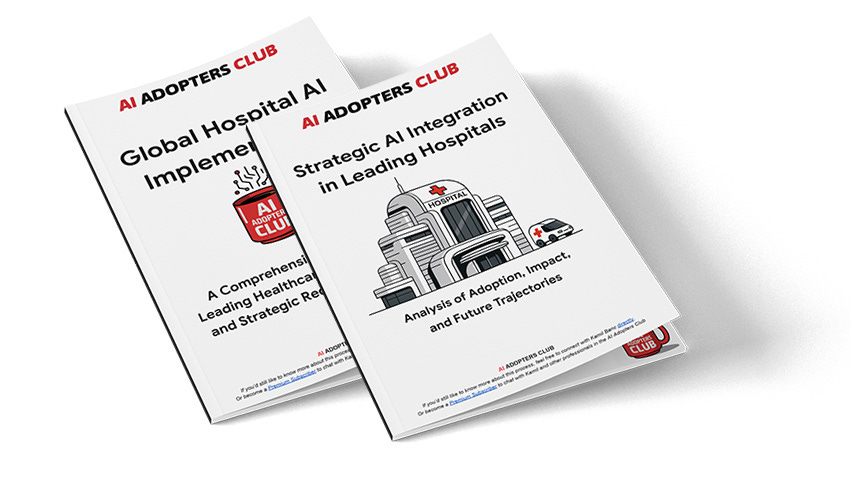From AI Failure to Hospital Success
Lessons from the winners and losers of medical AI adoption
Hey Adopter,
Here's a fact that should make every healthcare executive rethink their strategy: Mayo Clinic's AI can now detect early-stage pancreatic cancer with 97% accuracy. Not just any cancer. Pancreatic cancer. The one that kills 95% of patients within five years because it's caught too late.
Meanwhile, IBM Watson for Oncology, once hailed as the future of cancer treatment, became one of the most expensive failures in healthcare tech history.
The difference between these two outcomes isn't about the technology. It's about something far more fundamental that most hospital systems miss entirely.
The Billion-Dollar Mistake Nobody Talks About
IBM Watson for Oncology failed for a reason that should have been obvious from day one. The system was trained on data from a single U.S. hospital. That's like teaching someone to drive using only a parking lot, then expecting them to navigate rush hour traffic in Mumbai.
When hospitals in other countries tried to use Watson's recommendations, they discovered what any pragmatist could have predicted. The treatment protocols from one American hospital weren't relevant to patients in Asia, Europe, or even other parts of America.
This wasn't a technology failure. It was a strategy failure dressed up as innovation.
What Actually Works in Real Hospitals
While IBM was burning through budgets, leading hospital systems took a different approach. They didn't just build AI systems. They built what I call "implementation ecosystems."
Take Duke Health's command center. Instead of chasing flashy AI demos, they focused on solving actual operational problems. The result? A 6% increase in overall productivity, 50% cut in temporary labor costs, and 66% reduction in bed assignment wait times. Not theoretical gains. Real money saved, real problems solved.
At Mayo Clinic, they've moved beyond pilot projects to what they call "AI Factories." They're not just using one AI tool. They're deploying hundreds of AI applications at enterprise scale. Their latest win? Reducing discharge summary writing from 90 minutes to 10 minutes using generative AI.
Meanwhile, Moorfields Eye Hospital recognized that bias wasn't just a PR risk but a clinical one. So they developed an objective "Retinal Pigment Score" to ensure their AI works fairly across all ethnicities. No hand-waving about "we'll fix bias later." They baked equity into the system from the start.
The Numbers That Matter
Here's what happens when hospitals get AI implementation right:
HCA Healthcare's AI for cancer care coordination saves over 11,000 hours of manual work annually and cuts the time from diagnosis to first treatment by 6 days. That's not just efficiency. That's lives saved.
Ambient AI systems that listen to and summarize doctor-patient conversations are achieving a 55% reduction in clinician burnout. For every dollar spent, health systems see their net margin per encounter increase by multiples of that investment.
Seoul National University Hospital took things further. They built their own Korean-language medical AI that scored 86.2% on their national medical licensing exam, outperforming the average practicing physician.
The Strategic Shift You're Missing
Here's what separates the Mayo Clinics of the world from the Watson casualties: They've moved from asking "What can AI do?" to "What problems need solving?"
The winning philosophy isn't about replacing doctors. It's about what leaders call "Human-AI Collaboration." Use AI to handle data-intensive tasks so physicians can focus on patients. This isn't feel-good marketing speak. It's strategic positioning that drives adoption.
The real transformation happens when hospitals stop treating AI as a technology project and start treating it as an operational strategy. That means robust data governance, clinician engagement from day one, and building systems that scale beyond the initial pilot.
The Implementation Reality Check
Most hospital AI initiatives fail because they're solving the wrong problem. They're focused on the technology instead of the workflow. They're chasing AI novelty instead of business outcomes.
The successful hospitals have learned something crucial: The goal isn't to have AI. The goal is to solve problems that matter to patients, clinicians, and the bottom line.
Continue reading for the full strategic framework...
Inside the premium report, you'll discover:
The exact framework Mayo Clinic uses to deploy hundreds of AI tools at enterprise scale
Why ambient AI is achieving a 55% reduction in clinician burnout (and the specific implementation approach that makes it work)
How to identify which AI failures are actually strategy failures in disguise
The counterintuitive reason why "Human-AI Collaboration" beats pure automation every time
Case studies from Duke Health, Seoul National University Hospital, and other AI leaders
Also included with your download:
Risk mitigation checklist for algorithmic bias in medical AI
ROI calculator for healthcare AI initiatives (pre-populated with hospital benchmarks)
Case study library from Mayo Clinic, Duke Health, Moorfields, and other leading institutions
Quarterly briefings on emerging healthcare AI applications
Get instant access to both reports →







